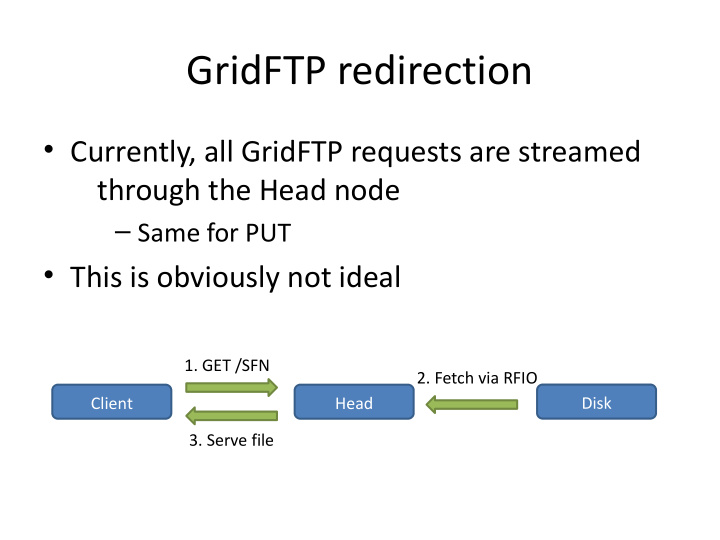



GridFTP redirection • Currently, all GridFTP requests are streamed through the Head node – Same for PUT • This is obviously not ideal 1. GET /SFN 2. Fetch via RFIO Client Head Disk 3. Serve file
GridFTP redirection • Based on the internal redirection mechanism in Globus’ GridFTP server – Currently, the redirection happens before asking for a filename, as this was originally intended for load balancing – Andrey has found that, with some modifications, it is possible to do the redirection when a file is requested • Internals are not well documented, so it is taking time
GridFTP redirection • Changes are only needed in the DSI plugin – Not in the GridFTP server – Neither in the clients • Any existing client (i.e. UberFTP) will follow transparently the redirection
FTS3 and xrootd • xrootd 3.3 will include third party copy support on both server and client side • We already have an experimental branch that uses this new functionality • The server must be upgraded to 3.3 for this to work • External plug-ins (i.e. dpm-xrootd) will need to be adapted
FTS3 and xrootd • When is it coming? – Hopefully, not too long after 3.3 is released • Which happened yesterday! • Will it make into EPEL? • What do we already have? – Third party copy – Checksum validation – Size validation
FTS3 and xrootd • What do we need? – Working endpoints (preferably from different vendors) for functional and stress tests •
FTS3 and http • No pure HTTP standard out there – Vendors as Google Cloud Storage or Amazon S3 use their own, not compatible, API’s • WebDAV RFC defines a COPY method, together with a destination header, so we use it instead – Although it doesn’t allow remote copies, it can be built over it
FTS3 and http • Since COPY is executed on the source, only a push model can be used – On the bright side, the destination could be any http(s) endpoint that supports PUT – The source SE orchestrates • Delegation is an issue – This bit is not standard, and will not work with out-of-the-box clients – A mechanism agreed between DPM and dCache
FTS3 and http (Delegation) • The endpoint redirects to itself (307) with a X-Delegate-To header only if needed. • The client does a Gridsite delegation to the URL specified with X-Delegate-To, and follow the redirect • The endpoint performs the copy – If no delegation was done, abort (the client may have not recognized the header)
FTS3 and http • GridFTP performance markers will be used to give feedback to the client – It is an already known format • The connection must stay alive during the copy – If the connection is closed, the copy will be canceled
FTS3 and http • When is it coming? – Soon after DPM and/or dCache have a working implementation • What do we already have? – A working prototype – No checksum validation, since http endpoints do not support this yet (DPM working on it) • What do we need? – A working implementation for both third party copy and checksum querying though http – At least a couple of working endpoints • Again, preferably from different vendors
FTS3, xrootd and http • One last comment: – FTS3 uses GFAL2 – GFAL2 is plug-in based – So xrootd and/or http third party copies can be enabled without upgrading FTS3 itself.
Recommend
More recommend